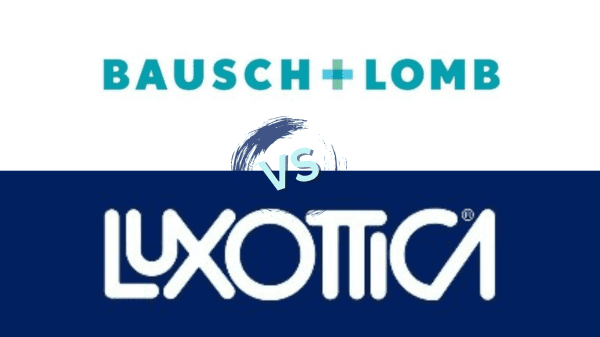
Bausch and Lomb and Luxottica stand out as titans in the expansive eyewear industry. Along with profoundly influencing consumer preferences and market dynamics, these brands have also impacted our perception of the eyewear industry. As consumers, it’s essential to understand the differences between these industry giants and how they have influenced the eyewear sector. This blog post aims to conduct a comparative analysis of Bausch and Lomb and Luxottica, examining their respective histories, product lines, business approaches, and influence within the industry.
Bausch and Lomb vs. Luxottica
Although Luxottica and Bausch & Lomb both have a large amount of power in the eyeglasses sector, they approach the market differently. Here are some distinctive differences the consumers should know of.
Innovation vs. Fashion Dominance
- Bausch and Lomb places a high value on optical innovation and precision, concentrating on the creation of cutting-edge technology for eye care and vision correction.
- Luxottica, on the other hand, prioritizes fashion and brand control by capitalizing on its vast assortment of brands to establish trends and influence consumer inclinations.
Product Selection and Market Reach
- To meet different visual demands, Bausch and Lomb provide a wide selection of eyewear products, such as contact lenses, prescription eyeglasses, and surgical equipment.
- The attractiveness of Luxottica’s fashion-forward eyewear brands, such as Prada and Ray-Ban, to customers looking for prestige and style, makes the company strong.
Production and Distribution
- With production facilities located across the globe, Bausch and Lomb maintain a substantial presence in the manufacturing sector, guaranteeing their products’ quality control and precision.
- Meanwhile, Luxottica’s vertical integration strategy grants it control over the entire eyewear supply chain, from design and manufacturing to retail distribution, enabling efficiency and brand synergy.
Bausch and Lomb: An Inaugural and Precise Heritage
John Jacob Bausch and Henry Lomb founded Bausch and Lomb in 1853, and the company has a long history of optical innovation and fine craftsmanship. The business first focused on making monocles and other optical devices before branching out into several categories of eyewear. Notably, Bausch and Lomb’s 1971 release of SofLens, the first soft contact lenses, transformed the eyeglass market.
As time went on, Bausch & Lomb kept pushing the boundaries of innovation, creating ground-breaking goods like the first polarized sunglasses to be mass-produced in 1936 and the renowned Ray-Ban Aviator sunglasses in 1937. Bausch and Lomb’s standing as a pioneer in the design and technology of eyewear was cemented by these advancements.
Luxottica: The Powerhouse of Eyewear Fashion and Retail
Conversely, Luxottica has established itself as a major player in the worldwide eyewear industry using vertical integration, brand licensing, and well-timed acquisitions. Leonardo Del Vecchio founded Luxottica in 1961 as a modest producer of eyeglass components that quickly grew into a retail outlet and a brand.
The portfolio of Luxottica includes a wide range of renowned eyewear brands, such as Oakley, Ray-Ban, Persol, and Vogue Eyewear. With a broad range of brands and designs available to customers in one location, Luxottica has become a market leader in the eyewear industry through its retail chains, which include Sunglass Hut, LensCrafters, and Pearle Vision.
Frequently Asked Questions About Bausch and Lomb vs Luxottica
1. What is Bausch and Lomb known for?
Bausch and Lomb is renowned for its innovations in optical technology and precision craftsmanship. The company introduced the first soft contact lenses, polarized sunglasses, and iconic eyewear brands like Ray-Ban.
2. What does Luxottica specialize in?
Luxottica specializes in fashion-forward eyewear, owning a vast portfolio of prestigious brands including Ray-Ban, Oakley, and Prada. The company is also a dominant force in eyewear retail with chains like Sunglass Hut and LensCrafters.
3. How do Bausch and Lomb and Luxottica differ in their approach to the eyewear market?
Bausch and Lomb prioritize optical innovation and precision, focusing on technologies for vision correction and eye care. In contrast, Luxottica emphasizes fashion and brand dominance, leveraging its extensive brand portfolio to dictate trends and shape consumer preferences.
4. What products do Bausch and Lomb offer?
Bausch and Lomb offers a diverse range of eyewear products, including contact lenses, prescription eyeglasses, and surgical instruments, catering to various vision needs.
5. What brands are owned by Luxottica?
Luxottica owns a vast portfolio of eyewear brands, including Ray-Ban, Oakley, Persol, Vogue Eyewear, and many others.
6. How does Luxottica control its eyewear supply chain?
Luxottica follows a vertical integration strategy, controlling the entire eyewear supply chain from design and manufacturing to retail distribution. This approach enables efficiency and brand synergy across its operations.
7. Which company has a stronger global presence?
Both Bausch and Lomb and Luxottica have a strong global presence, but Luxottica’s retail chains like Sunglass Hut and LensCrafters contribute to its widespread visibility in various markets.
8. Are Bausch and Lomb and Luxottica competitors?
While Bausch and Lomb and Luxottica operate in the same industry, their focus areas differ significantly. Bausch and Lomb primarily concentrate on optical technology and eye care, whereas Luxottica dominates the fashion eyewear market. However, there might be some overlap in certain segments, making them indirect competitors in some contexts.
9. Which company is more focused on innovation?
Bausch and Lomb has a long history of innovation in optical technology, introducing groundbreaking products like soft contact lenses and polarized sunglasses. While Luxottica focuses more on fashion and brand dominance, it does invest in innovation, particularly in materials and design within the fashion eyewear sector.
10. How do consumers benefit from the rivalry between Bausch and Lomb and Luxottica?
The rivalry between Bausch and Lomb and Luxottica drives innovation, diversity, and choice in the eyewear market. Consumers can choose from a wide range of products catering to different preferences, whether they prioritize optical performance, fashion trends, or a combination of both.
Conclusion
Luxottica and Bausch and Lomb stand out as strong competitors, each with their advantages and contributions. Bausch & Lomb maintains a tradition of optical innovation and accuracy, but Luxottica’s wide range of brands and retail expertise make it the industry leader in fashion.
Knowing the distinctions between these titans of the business helps us, as customers, make well-informed decisions about the types of eyeglasses we like, regardless of whether we value fashion trends, technology breakthroughs, or a combination of the two. In the end, the competition between Luxottica and Bausch & Lomb propels innovation and diversity in the eyeglasses industry, improving our quality of life and visual experiences.

Leave a Reply